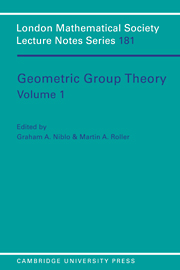Book contents
- Frontmatter
- Contents
- Preface
- List of Participants
- 1 Group Actions and Riemann Surfaces
- 2 The Virtual Cohomological Dimension of Coxeter Groups
- 3 The Geometric Invariants of a Group A Survey with Emphasis on the Homotopical Approach
- 4 String Rewriting — A Survey for Group Theorists
- 5 One Relator Products and High-Powered Relators
- 6 An Inaccessible Group
- 7 Isoperimetric and Isodiametric Functions of Finite Presentations
- 8 On Hibert's Metric for Simplices
- 9 Software for Automatic Groups, Isomorphism Testing and Finitely Presented Groups
- 10 Proving Certain Groups Infinite
- 11 Some Applications of Small Cancellation Theory to One-Relator Groups and One-Relator Products
- 12 A Group Theoretic Proof of the Torus Theorem
- 13 N-Torsion and Applications
- 14 Surface Groups and Quasi-Convexity
- 15 Constructing Group Actions on Trees
- 16 Brick's Quasi Simple Filtrations and 3-Manifolds
- 17 A Note on Accessibility
- 18 Geometric Group Theory 1991 Problem List
5 - One Relator Products and High-Powered Relators
Published online by Cambridge University Press: 15 March 2010
- Frontmatter
- Contents
- Preface
- List of Participants
- 1 Group Actions and Riemann Surfaces
- 2 The Virtual Cohomological Dimension of Coxeter Groups
- 3 The Geometric Invariants of a Group A Survey with Emphasis on the Homotopical Approach
- 4 String Rewriting — A Survey for Group Theorists
- 5 One Relator Products and High-Powered Relators
- 6 An Inaccessible Group
- 7 Isoperimetric and Isodiametric Functions of Finite Presentations
- 8 On Hibert's Metric for Simplices
- 9 Software for Automatic Groups, Isomorphism Testing and Finitely Presented Groups
- 10 Proving Certain Groups Infinite
- 11 Some Applications of Small Cancellation Theory to One-Relator Groups and One-Relator Products
- 12 A Group Theoretic Proof of the Torus Theorem
- 13 N-Torsion and Applications
- 14 Surface Groups and Quasi-Convexity
- 15 Constructing Group Actions on Trees
- 16 Brick's Quasi Simple Filtrations and 3-Manifolds
- 17 A Note on Accessibility
- 18 Geometric Group Theory 1991 Problem List
Summary
Abstract. If G = (x1, …, xn \ rm) is a one-relator group for some large integer m, then it is well known that G has many nice properties, and these are often easier to prove than in the torsion-free case (where the relator is not a proper power). To a large extent, this phenomenon also occurs for a one-relator product G = (A * B)/N(rm) of arbitrary groups A, B (where N(·) means normal closure). In this article we survey some recent results about such groups, describe the geometric methods used to prove these results, and discuss what happens for lower values of m. Specifically, we give counterexamples to a conjecture made in [36].
Introduction
Given a set X = {x1, x2, x3,…} and a word r on X ∪ X−1 the group G given by the presentation (x1, x2, x3,… | r) is said to be a one-relator group. An extensive and successful theory of one-relator groups has been established, based largely on the work of W. Magnus, and generalising the theory of free groups (see [44], Chapter II). The theory of one-relator groups provides a basic model and an extensive stock of techniques for further generalization of free groups. With this aim in mind, one possibility is to consider presentations with more than one relator. This idea has been been successfully pursued by I.L. Anshel [1] for the case of two-relator groups (see also [40] for a particular class of two-relator groups). Bogley [4] has also extended a number of one-relator group theorems to certain groups with arbitrarily many relations.
- Type
- Chapter
- Information
- Geometric Group Theory , pp. 48 - 74Publisher: Cambridge University PressPrint publication year: 1993
- 5
- Cited by



